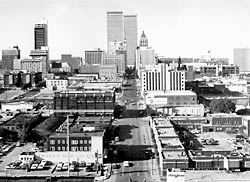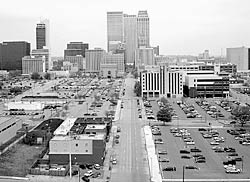Bill Leighty on historic preservation
Tulsa Metropolitan Area Planning Commission chairman Bill Leighty has an excellent op-ed in the latest issue of Urban Tulsa Weekly about the importance of historical preservation to Tulsa's future.
I'm tempted to quote the whole thing. The heart of the article is an account of a recent Preservation Leadership Training workshop put on by the City of Tulsa Planning Department.
In a nutshell, the training included an examination of the financial incentives and other economic considerations in redeveloping historic structures. It also explored how historic preservation as an intervention strategy and policy impacts local economic development. Participants followed the progress of prototype projects and applied this knowledge to demonstration projects located here in Tulsa.
In the course of the article, Leighty addresses the lack of support for historic preservation from Tulsa's political and business leaders and the personal impact of then-and-now photos of downtown Tulsa:
At one point in the slide show, a photo taken in mid 1970's looking north on Boston Avenue from high up in the tower of Boston Avenue United Methodist Church was featured. When it transitioned into the next photo, taken from exactly the same perspective about 35 to 40 years later, the entire audience let out a collective gasp at the dramatically changed landscape.The first photo documented a vibrant, densely populated urban core that had been reduced to a barren sea of asphalt only a few decades later. The loss of so many historic structures obviously stunned everyone, even the locals. It was a pretty dramatic moment for everyone and it left me with a lump in my throat. I can honestly say it was a turning point for me. I get it now, I so get it.
Photos of Tulsa's Boston Avenue, looking north toward the BOK Tower, in 1978 (left) and 2005 (right); from the Tulsa Preservation Commission's article about endangered downtown Tulsa.
Leighty goes on to catalog the documented economic and quality-of-life benefits of historic preservation, including the value of old buildings to new businesses:
The creative and adaptive reuse of historic buildings has proven to be remarkably versatile in meeting the demands of a wide range of uses. These buildings often provide affordable rent, thereby serving as incubators for entrepreneurs and growing small businesses which account for 85 percent of all the new jobs created in America. Properly executed historic preservation efforts are great examples of the physical sustainability of the built environment, and the functional sustainability of public infrastructure.
The fun, interesting places to be in Tulsa on a weekend night -- Brookside, Blue Dome, Bob Wills District, 18th & Boston, Cherry Street -- are all significant clusters of older buildings that were overlooked by urban renewal and spared from expressway construction. Blue Dome and the Bob Wills District owe a great deal to people like David Sharp, who started buying up buildings to keep them from being torn down for parking. These thriving districts were not developed with public funds.
Leighty points out that, while there are Tulsans actively engaged in adaptive reuse of historic buildings and advocacy for historic preservation, we need elected officials and business leaders to "buy into and support these initiatives" in order for historic preservation to gain traction.
When you look at successful historic preservation in other cities, you will find their efforts began with a group of influential people (often the wives of business tycoons) who were outraged by the demolition of a local landmark. San Antonio and Savannah are two such examples.
Here in Tulsa, business leaders have actively opposed historic preservation and tarred preservation advocates as naysayers enemies of growth, working to keep them off of the City Council, TMAPC, Board of Adjustment, even the Tulsa Preservation Commission.
The tide may be beginning to turn. It was encouraging to see a positive mention of preservation in the Tulsa Metro Chamber's 2011 city election manifesto:
While preservation of Tulsa's historic neighborhoods and structures is paramount, this also requires a transition from residence-only neighborhoods to multi-purpose building that intentionally preserves the character of the area.The Tulsa Metro Chamber is willing to work toward a model of shared use which accommodates both the need for safe neighborhoods and the preservation of historic areas; while also providing its residents with retail possibilities, increasing walkability, and creating distinct centers of urban density.
The second half of Leighty's essay covers the demonstration project his team undertook as part of the workshop -- taking an underutilized building, examining possibilities for adaptive reuse, and proposing an economically feasible approach to reuse. His team of three proposed an indoor farmer's market for the old International Harvester Building on the southeast corner of 2nd and Frankfort:
The building is rather unassuming with minimum architectural details. I had driven by many times without so much as a second look. That changed the minute I walked into the building, which is basically divided into two sections, the former showroom in the front and the warehouse like space which formerly housed the service and parts department in the back. There are concrete floors, a barrel roof supported by intricate steel joists and super structure, and broad open expanses with skylights....Our proposal includes financial projections indicating both relatively low total development costs and a healthy cash flow. In other words, it is not just a sound idea for a great addition to downtown Tulsa, but a very viable business opportunity.
As I said, read the whole thing, and say a prayer of thanks that a man of Bill Leighty's insight heads up our city's planning commission.
0 TrackBacks
Listed below are links to blogs that reference this entry: Bill Leighty on historic preservation.
TrackBack URL for this entry: https://www.batesline.com/cgi-bin/mt/mt-tb.cgi/6104

